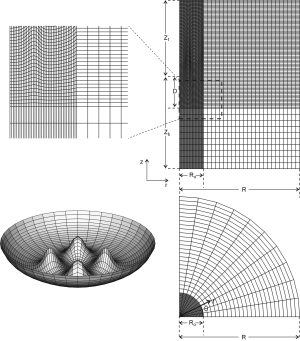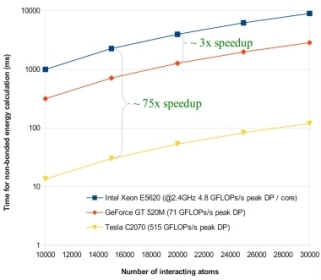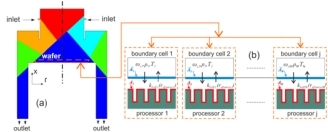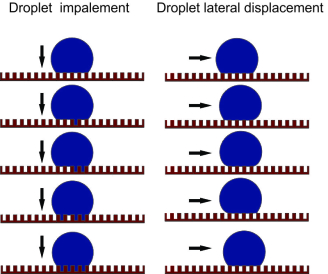Large scale 3D Finite Element Computations
The combination of Krylov subspace projection methods and good preconditioning is the state-of-the-art
in the iterative solution of large algebraic equation systems. The efficiency of the method is due to the small
memory requirements and the reduced computational cost when it is used on parallel computers.
The Generalized Minimum Residual Method - GMRES, in particular, is the method of preference for the solution of
large, sparse and non-symmetric linear systems, such as those arising from the discretization of partial differential
equations with the Galerkin/finite element method.

Normal Field instability
The case under study is drawn from the equilibrium and stability of free surfaces of ferromagnetic liquids. A ferromagnetic liquid pool, is placed in an external magnetic field applied normally to the flat surface of the pool. The applied field is uniform away from the pool. Close to the pool it deviates from uniformity, due to the demagnetizing field of the pool itself. The flat free surface turns unstable when the applied field strength exceeds a threshold. It becomes highly distorted in an ordered deformation composed of peaks and interspersed troughs arranged in a hexagonal or occasionally square pattern.

Brain Functional Connectivity during Working Memory Tasks
Understanding the mechanisms that pertain to the function of working memory (WM) is a fundamental and still open problem in neuroscience. WM is considered to have a key-role in higher-level cognitive processes such as decision making, reasoning and recognition, since it is in charge of holding and simultaneously manipulating a small amount of information stored in the mind for a limited period of time for further processing. With the aid of Spectral Granger Causality approach on a set of ~2100 (trials) x 56 (EEG electrodes) x 4500 (time points) it was shown that visuo-spatial information can be fully dissociated between different tasks (movement-planning vs. perceptual/change detection) and memory conditions (memory vs. non memory). The results favour the hypothesis which considers spatial WM as a by-product of specific mental processes that engages common brain areas under different complex network organizations.

GPU-accelerated Molecular Simulations of Polymer-matrix Nanocomposites
Polymer-matrix nanocomposites, play an increasingly important role in automotive, energy, industrial separation, and biomedical applications. The Computational Material Science and Engineering Group (CoMSE) has integrated the unprecedented computational power of GPU computing into a MC scheme enabling equilibration of polymeric melts and polymer-matrix nanocomposite systems at large length scales. Our strategy for parallelizing MC codes for use with nVIDIA GPUs supporting CUDA involves concurrent calculation of the bonded interactions at the CPU and non-bonded interactions at the GPU. Well equilibrated MC configurations have been used to predict the structure (grafted corona thickness) and thermodynamic properties of long-chain PE and PS pure and nanocomposite melts.

Parallel multiscale analysis of chemical vapor deposition processes
Nowadays, since the size of the fabricated devices shrinks to lower scales, the specifications of the materials produced via Chemical Vapor Deposition (CVD) refer to properties in micro- or nano- scale. Thus, the single scale conventional CVD modeling methods are not adequate. A multiscale modeling framework has been developed to couple the co-existing scales i.e. macro-, micro- and nano- scale, in CVD processes. The framework consists of a Reactor Scale Model for the description of the transport phenomena in the bulk phase (macro- scale) of a CVD reactor and two models for the micro- and nano- scale: a) A Feature Scale Model describing the growth of a film inside features on a predefined micro- topography on the wafer and b) a Nano Morphology Model describing the morphology evolution during thin film deposition of an initially flat surface. The description of such complex physical/chemical phenomena, demands efficient parallel methodologies that can handle the high computational demands of such approaches. A multi-parallel scheme is supported which efficiently accelerates the multiscale computations. In the macro- scale, acceleration is achieved by using domain decompositions techniques and in the micro- and nano- scales by using a master-worker parallel technique. The multi- parallel term, stems from the fact that different number of processors can be used during the computations in the different scales. The latter guarantees the efficiency of the multiscale computations.

Wetting transitions of droplets on patterned surfaces
Patterned surfaces are widely incorporated in applications of microfluidics, such as microfluidic channels, microvalves without mechanical parts, self-cleaning surfaces etc. We develop computational methods that facilitate the optimal design of the surface patterns, by simulating various types of wetting transitions. The simulations are computationally intensive and utilize the massively parallel execution on GPUs, to tackle problems with tens of millions of unknowns.

Electrowetting modeling on structured dielectric surfaces
Electrowetting (i.e. the electrostatically induced wettability enhancement of a solid by a liquid) is a convenient tool for manipulating microdroplets in a variety of contemporary applications (e.g. liquid lenses, lab-on-a-chip systems etc.). We have developed a continuum-level modeling approach based on an augmented Young-Laplace equation which states the stress balance between the capillary, electrostatic and micro-scale solid-liquid interaction forces on a droplet surface. The proposed methodology can be readily applied to simulate electrowetting phenomena on any kind of solid surface topography and could be proven to be a valuable tool for understanding the effect of geometric characteristics on wetting transitions.
